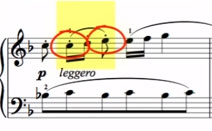Today we are going to present a very important topic for all pianists out there: The Challenge of the Thumbs. The thumbs are your strongest fingers yet they propose one of the biggest challenges when it comes to playing the piano. We are going to talk about this today and I will offer some solutions for how to deal with these sometimes cumbersome, strong fingers.
If you place your hands side by side you’ll see that your thumbs are in the middle and your smaller fingers are on the ends.

This matters a great deal in piano playing because your thumbs are your strongest fingers and your fourth and fifth fingers are your weakest. Despite our anatomy, you want to delineate the melody on the top and the bass on the bottom which means that your weakest fingers must produce the most sound!
Without balancing your hands and letting your thumbs dominante you will get a muddy sound. This really is a cruel trick of nature since you want to bring out the melody and bass but we are stuck playing them with your weakest fingers. So how do you compensate for this?
There are a few ways to practice and train yourself to compensate for the strength of your thumbs. I recommend practicing with different phrasing by making the top and bottom notes legato and playing the inner voices with a light staccato from the fingers. This is a tricky thing to do but it’s something that you can apply to almost all your music helping to delineate melody and bass. Training yourself to play this way will certainly help you bring out the top and bottom notes on the melody and bass without having the thumbs dominate the sound.
Try practicing the melody and bass separately. Practice the outer notes with your pinky and fourth finger and playing them legato and then practice playing the inner melody with your thumb and inner fingers with a light staccato. If done correctly these can really improve the control in your piano playing.
I’d love to hear from everyone and learn your thoughts on this subject. Thanks again for joining us here at Living Pianos. info@LivingPianos.com (949) 244-3729














